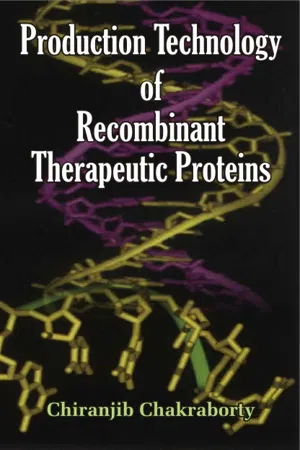
- English
- PDF
- Available on iOS & Android
eBook - PDF
Production Technology of Recombinant Therapeutic Proteins
Frequently asked questions
Yes, you can cancel anytime from the Subscription tab in your account settings on the Perlego website. Your subscription will stay active until the end of your current billing period. Learn how to cancel your subscription.
At the moment all of our mobile-responsive ePub books are available to download via the app. Most of our PDFs are also available to download and we're working on making the final remaining ones downloadable now. Learn more here.
Perlego offers two plans: Essential and Complete
- Essential is ideal for learners and professionals who enjoy exploring a wide range of subjects. Access the Essential Library with 800,000+ trusted titles and best-sellers across business, personal growth, and the humanities. Includes unlimited reading time and Standard Read Aloud voice.
- Complete: Perfect for advanced learners and researchers needing full, unrestricted access. Unlock 1.4M+ books across hundreds of subjects, including academic and specialized titles. The Complete Plan also includes advanced features like Premium Read Aloud and Research Assistant.
We are an online textbook subscription service, where you can get access to an entire online library for less than the price of a single book per month. With over 1 million books across 1000+ topics, we’ve got you covered! Learn more here.
Look out for the read-aloud symbol on your next book to see if you can listen to it. The read-aloud tool reads text aloud for you, highlighting the text as it is being read. You can pause it, speed it up and slow it down. Learn more here.
Yes! You can use the Perlego app on both iOS or Android devices to read anytime, anywhere — even offline. Perfect for commutes or when you’re on the go.
Please note we cannot support devices running on iOS 13 and Android 7 or earlier. Learn more about using the app.
Please note we cannot support devices running on iOS 13 and Android 7 or earlier. Learn more about using the app.
Yes, you can access Production Technology of Recombinant Therapeutic Proteins by Chakraborty, Chiranjib in PDF and/or ePUB format, as well as other popular books in Medicine & Biotechnology in Medicine. We have over one million books available in our catalogue for you to explore.
Information
Topic
MedicineSubtopic
Biotechnology in MedicineTable of contents
- Cover
- Design of a Therapeutic Protein Production Plant
- Preface
- Part I: Recombinant Protein Expression Into Escherichia Coliand Fermentation Conditions
- 1. Introduction
- 2. Construction of Efficient Expression Vector (Plasmid)
- 3. Factors Affecting Transcription
- 4. mRNA Stability
- 5. Factors Affecting Translation
- 6. Expression of Target Protein and the Compartments of Expression
- 7. Fusion Proteins
- 8. Post-translational Protein Folding
- 9. Codon Usage
- 10. Protein Degradation
- 11. Fermentation Conditions for High-density Cell Cultivation (HDCC)
- 12. One Examples of Protein Production Using E. coliExpression System
- 13. Conclusion
- Part II: Recombinant Protein: Expression Into Yeast, Pichia Pastoris and Fermentation Conditions
- 1. Introduction
- 2. Why P. pastoris?
- 3. Construction of Expression Strains
- 4. Post-translational Modification of Secreted Proteins
- 5. Production of Recombinant Proteins in Fermenter Cultures of the Yeast, Pichia pastoris
- 6. One Examples of Protein Production Using P. pastorisExpression System
- 7. Conclusion
- Part III: Purification Strategies for Recombinant Proteins
- 1. Purification of Proteins
- 2. Conventional Chromatography
- Part V: Market Size And Cost Analysis For The Production of Therapeutic Proteins
- 1. Market Size of Therapeutic Proteins
- 2. Outline Structure of a Production Unit and Cost Analysis for the Production of Three Therapeutic Proteins
- Patrt VI: General Experimental Protocols
- 1. Different Experimental Protocols
- References
- Index